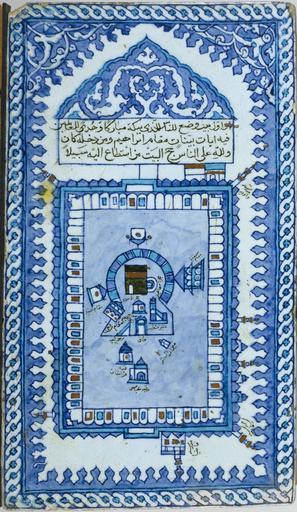MAKE A MEME
View Large Image

| View Original: | Turkish_-_Tile_with_the_Great_Mosque_of_Mecca_-_Walters_481307_-_View_A.jpg (1044x1799) | |||
| Download: | Original | Medium | Small | Thumb |
| Courtesy of: | commons.wikimedia.org | More Like This | ||
| Keywords: Turkish - Tile with the Great Mosque of Mecca - Walters 481307 - View A.jpg The three lines of Arabic writing in the upper part of this large ceramic wall tile are from the third chapter of the Qur'an and exhort the Muslim faithful to make the pilgrimmage to Mecca The rest of the tile is given over to a bird's-eye representation of the Great Mosque in Mecca with the Ka'ba Islam's holiest shrine in the center surrounded by various other structures all identified in Arabic and a rectangular portico around the courtyard Such tiles may have been created to remind Muslims of their obligation to make the pilgrimage and to introduce potential hajji or pilgrims to the places and practices they would encounter in Mecca The plaques also may have been intended for commemoration and contemplation following a hajji's experience at the Ka'ba century 17 Ottoman fritware with underglaze painting cm 62 4 35 8 3 5 accession number 48 1307 17197 Henry Walters Baltimore 1897 mode of acquisition unknown Walters Art Museum Henry Walters Acquired by Henry Walters 1897 Translation From Qur'an 3 96-97 The first House established for the people was that at Bekka Mecca a place holy and a guidance to all beings Therein are clear signs- the station of Abraham and whosoever enters it is in security It is the duty of all men towards God to come to the House a pilgrim if he is able to make his way there The Divine Word and Sacred Sites of Islam The Walters Art Gallery Baltimore 1997 Highlights from the Collection The Walters Art Gallery Baltimore 1998-2001 Maps Finding Our Place in the World The Field Museum Chicago; The Walters Art Museum Baltimore 2007-2008 place of origin Iznik in present-day Turkey Walters Art Museum license 2D Islamic art in the Walters Art Museum Art from Turkey Media contributed by the Walters Art Museum needs category review Hajj 1700s İznik ceramics | ||||